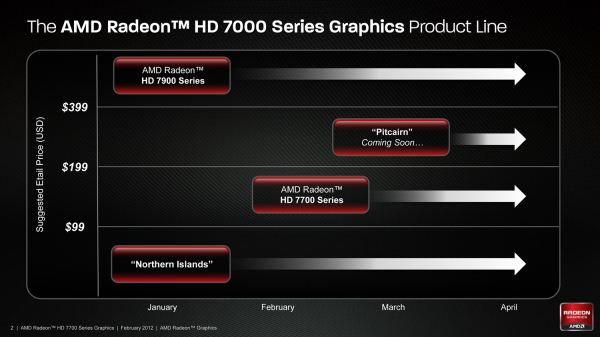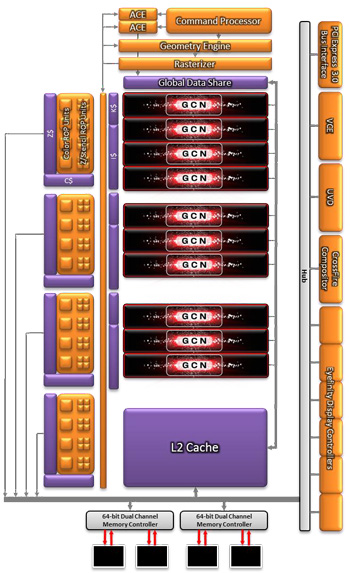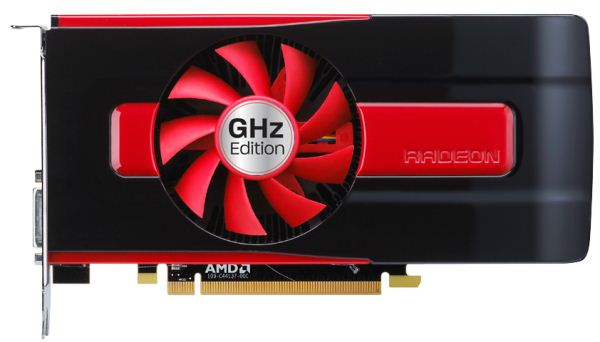AMD Radeon HD 7750 & Radeon HD 7770 GHz Edition Review: Evading The Price/Performance Curve
by Ryan Smith & Ganesh T S on February 15, 2012 12:01 AM EST- Posted in
- GPUs
- AMD
- HTPC
- GCN
- Radeon HD 7000
With the launch of Tahiti behind them, AMD is now firing on all cylinders to get the rest of their Southern Islands lineup out the door. Typically we’d see AMD launch their GPUs in descending order of performance, but this time AMD is taking a slight detour. Rather than following up the Tahiti based 7900 series with the Pitcairn based 7800 series, AMD is instead going straight to the bottom and launching the Cape Verde based 7700 series first.
Today AMD will be launching two cards based on the Cape Verde GPU: the Radeon HD 7750, and the Radeon HD 7770 GHz Edition. As the Juniper based 5700 series never got a proper Northern Islands successor, this is the first real update for the x700 series since the launch of the 5700 series in October of 2009. Given the success of the 5700 expectations are going to be high, and to fulfill those expectations AMD will be bringing to bear their new GCN architecture along with a full node jump with TSMC’s 28nm process. But will this be enough to enable the 7700 series to replicate the success of the 5700 series? Let’s find out.
| AMD GPU Specification Comparison | |||||||
| AMD Radeon HD 7770 GHz Edition | AMD Radeon HD 7750 | AMD Radeon HD 6850 | AMD Radeon HD 5770 | AMD Radeon HD 5750 | |||
| Stream Processors | 640 | 512 | 960 | 800 | 720 | ||
| Texture Units | 40 | 32 | 48 | 40 | 36 | ||
| ROPs | 16 | 16 | 32 | 16 | 16 | ||
| Core Clock | 1000MHz | 800MHz | 850MHz | 850MHz | 700MHz | ||
| Memory Clock | 4.5GHz GDDR5 | 4.5GHz GDDR5 | 4.8GHz GDDR5 | 4.8GHz GDDR5 | 4.6GHz GDDR5 | ||
| Memory Bus Width | 128-bit | 128-bit | 256-bit | 128-bit | 128-bit | ||
| Frame Buffer | 1GB | 1GB | 1GB | 1GB | 2GB | ||
| FP64 | 1/16 | 1/16 | N/A | N/A | N/A | ||
| Transistor Count | 1.5B | 1.5B | 1.7B | 1.04B | 1.04B | ||
| PowerTune Limit | 100W | 75W | N/A | N/A | N/A | ||
| Manufacturing Process | TSMC 28nm | TSMC 28nm | TSMC 40nm | TSMC 40nm | TSMC 40nm | ||
| Architecture | GCN | GCN | VLIW5 | VLIW5 | VLIW5 | ||
| Price Point | $159 | $109 | ~$149 | ~$99 | ~$89 | ||
With the 6000 series AMD effectively had a 5 chip stack: Caicos (6400), Turks (6600), the rebadged Juniper (6700), Barts (6800), and Cayman (6900). Since then integrated GPUs have effectively wiped out the low end of the market, and by the time Trinity launches later this year any product short of 6600 performance should be made redundant. As a result AMD has reigned in on their spread out stacks, leading to their 28nm Southern Islands product stack being just 3 products: Cape Verde (7700), Pitcairn (7800), and Tahiti (7900). Anything below the 7700 series will be rebadged Northern Islands parts, primarily Turks and Caicos.
But AMD’s product stack doesn’t tell the whole story. AMD will need to cover a wide range of products and price levels with only 3 GPUs, ranging from $109 to $550. As a result the performance levels of AMD’s various product series are being redefined somewhat, and nowhere is this more apparent right now than with the 7700 series. Why do we say that? Well let’s take a look at the specs and pricing.
Cape Verde, the GPU at the heart of the 7700 series, is AMD’s smallest 28nm GPU. With a die size of 123mm2 it’s only a hair bigger than the 118mm2 Turks GPU that powers the 6600 series. In terms of functional units we’re looking at 10 Compute Units, giving Cape Verde 640 SPs and 40 texture units. Elsewhere Cape Verde packs 16 ROPs, 1 geometry engine/rasterizer pair, and 512KB of L2 cache, with the chip coupled to a 128bit GDDR5 memory bus. Altogether compared to Tahiti this is around 31% of the CUs, 33% of the memory bus width, and half as many ROPs.
Interestingly, unlike Tahiti, Cape Verde’s CUs are organized slightly differently. GCN is designed around 4 CUs in each CU Array, with the 4 CUs sharing a read-only L1 instruction cache and a read-only L1 data cache. This is how both the 7970 and 7950 are organized, with the 7950 simply lopping off a whole CU array. However with Cape Verde 10 CUs doesn’t cleanly divide into groups of 4, so for the first time AMD has built something a bit different. In Cape Verde there are 3 CU arrays, populated in a 4/3/3 manner. With regards to performance there shouldn’t be a huge difference, but this does mean that there’s a bit less cache pressure on the CUs occupying the smaller CU arrays.
On the functionality side of things, backing up Cape Verde will be the rest of the Southern Islands family features we’ve already seen on Tahiti, such as DX10+ SSAA, PowerTune, Fast HDMI support, partially resident textures, D3D 11.1 support, and the still-AWOL Video Codec Engine (VCE). Even FP64 support is accounted for, however similar to how NVIDIA handles it on lower-end parts it’s a performance-limited implementation for compatibility and software development purposes, with FP64 performance limited to 1/16th FP32 performance.
As for the cards themselves, AMD will be releasing two Cape Verde cards: the Radeon HD 7750, and the Radeon HD 7770 GHz Edition. The 7770 will be a fully enabled Cape Verde with all 10 CUs (640 SPs) enabled, running at 1GHz for the core clock and 4.5GHz for the memory clock, with a PowerTune limit of 100W and an AMD defined typical board power of 80W. The 7750 meanwhile has 2 disabled CUs, giving it 512 SPs and 32 texture units, while the ROP count is unchanged at 16. The core clock will be 800MHz while the memory clock is the same as the 7770 at 4.5GHz, with a PowerTune limit of 75W and a typical board power of 55W. Both cards have a sub-10W idle TDP, while long-idle is sub-3W.
With those specs in mind, it’s interesting to note that the difference between the 7750 and 7770 is much wider than we’ve seen in past products. Compared to the 7750, the 7770 has 25% more CUs and a 25% core clock advantage, giving it a massive 56% shader and texture performance advantage over the 7750. With the 5700 series this gap was only 35%, and most of that was a result of core clock differences. The fact that the memory bandwidth is the same between the 7770 and 7750 equalizes things somewhat, but it’s still a huge difference for two cards that are in the same family.
This brings us back to where we started: how AMD is covering the entire $109+ market with only 3 GPUs. Between the massive performance gap between the 7700 series cards and the fact that the 7750 is a sub-75W part, it becomes increasingly obvious that the 7700 series is the de-facto replacement for both the 6600 series and the 5700 series. The 7750 will fill the 6670’s old role as AMD’s top sub-75W card, but as we’ll see its performance means it won’t be a complete replacement for the 5700 series. Instead the role of replacing the 5700 series falls to the much more powerful 7770.
As for today’s launch, AMD will be launching the 7750 at $109 and the 7770 at $159, which happens to be the same prices the 5770 and 5750 512MB launched at respectively. With midrange cards there usually aren’t any supply issues and we aren’t expecting the 7700 series launch to be any different, however as is customary AMD’s partners will be launching semi-custom cards from day one, so pricing will probably be inconsistent.
At these prices the 7700 series will be competing with a number of last-generation cards. The 7750 will be up against AMD’s 5770/6770 and the absolute cheapest of NVIDIA’s GTX 550 Ti cards. Meanwhile the 7770 will be competing with AMD’s 6850 and 6870, along with NVIDIA’s GTX 460 and their cheapest GTX 560s. And as we’ll see in our benchmarks, this is ultimately going to be more than the 7700 series can handle.
| Winter 2011/2012 GPU Pricing Comparison | |||||
| AMD | Price | NVIDIA | |||
| $209 | GeForce GTX 560 Ti | ||||
| $179 | GeForce GTX 560 | ||||
| Radeon HD 6870 | $169 | ||||
| Radeon HD 7770 | $159 | ||||
| Radeon HD 6850 | $139 | ||||
| $119 | GeForce GTX 550 Ti | ||||
| Radeon HD 7750 | $109 | ||||
| Radeon HD 6770 | $99 | ||||













155 Comments
View All Comments
anactoraaron - Wednesday, February 15, 2012 - link
What happened there at 1920x1200 for the 6870? 23.2 fps seems a bit off to me. I get a solid 60 just about everywhere (occasional dips to ~50) at 1080.I am so glad I bought a 6870 ICEQ a month ago. Got the email today that I will be getting my rebate so your point about getting a 6870 for 159 AR is absolutely true. And the ICEQ edition I have is rocking a 1000/1150 oc all day long 32c idle 69c load via furmark 15 min run. Best part is it's much quieter than a reference card.
All of the 7xxx releases seem a bit lackluster to me.
Ryan Smith - Wednesday, February 15, 2012 - link
I go over this a bit in the commentary for that benchmark, but basically the 1GB cards are running out of memory in that benchmark. For reasons I've yet to determine, even though the 7700 series cards still only have 1GB they are handling the situation better than the 6800 and 5700.bazinga77 - Wednesday, February 15, 2012 - link
first thing that should be pointed out is that i believe that the 7700 series cards that launched today only have a 128 bit memory interface so no one should expect miracles especially at higher resolutions. the memory bandwidth on x700 cards and lower has always held them back a little, where as nvidia for instance on their 550ti uses a 192 bit memory interface. if this card used a higher bandwidth memory it would do better. also the 79xx series from amd upped the bandwidth from the 69xx series from 256 bit to 384 bit which is probably one of the reasons it was so impressive.well the gtx 460 is starting to disappear and amd discontinued the 6850 and 6870 two months ago so once they are gone they are gone. this is directly from amd. so i think this card fits in nicely and i expect once the 7850 launches that the price of this card will drop. i think that the 7770 almost being as fast as the 6850 isn't all that bad, especially because of how cool it runs and it seems like the factory oc cards close that gap even closer. considering how much power some of these cards took a couple of generations ago it seems like we are making progress. once the 7850 launches, which i believe happens next month, i think it will be the card to get, just as the 6850 was.
so all in all it seems like the 7770 will fit in nicely with a small price drop and and the discontinuation of some of the older amd and nvidia cards that has been happening, let alone taking into account the promotions we might see with rebates on these cards or bundled games etc.
lastly the 7750 seems like it will now be the best card on the market that doesn't require an external power connector and it will come in at only about $10 more than the current champ in that arena. so it looks like a nice card for the casual gamer or someone looking for an htpc card and it looks like the encoding features of the 77xx cards are pretty great.
chizow - Wednesday, February 15, 2012 - link
Like I said in the 7970 and 7950 review comments, the reality of the situation is only going to get worst as AMD reveals the rest of their 7-series product stack.Ryan I can tell you're doing your best not to be too hard on AMD but there comes a time we need to call a spade a spade. What AMD is doing here in terms of price and performance with the 7-series is easily the worst we've ever seen in the last decade from a new GPU architecture, especially considering they're also on a new process node.
If/when Nvidia pulls an RV770 on AMD, I really hope you and the rest of the media is up to the task the same way they were with the GTX 280. I don't think you were head GPU editor at that time but I'm sure you remember the backlash.
jjj - Wednesday, February 15, 2012 - link
So AMD either went stupid all of the sudden or they just can't produce enough cards yet and priced them to not sell.Either way,this is a mistake and they are only hurting their image (something they can't afford since Nvidia is still the stronger brand).Lets hope Nvidia wants market share and gives us something exciting soon.
stolid - Wednesday, February 15, 2012 - link
Arg. Might as well hang on to my 5770's. :/adonn78 - Wednesday, February 15, 2012 - link
And these cards are supossed to be an upgrade over the 6000 series how?Targon - Wednesday, February 15, 2012 - link
There is still a 7800 series set of cards that we have not seen yet. We saw the 7900 cards, and now the 7700 series. The comparisons here are 7700 vs. 6800 series, and that is ONE issue.Price vs. performance is the primary issue that I can see, and TIME will hopefully bring down the prices to a reasonable level. I also hope/expect that there are reasons for the prices that will be fixed quickly, so will reduce the prices. We shall see, but if NVIDIA is having problems, it may be that AMD is giving NVIDIA a chance to come back, and is saving their next big performance jump for that release.
chizow - Wednesday, February 15, 2012 - link
"Price vs. performance is the primary issue that I can see, and TIME will hopefully bring down the prices to a reasonable level."But that's exactly the problem, time hasn't brought price down to a reasonable level because we've already had 14+ months of this performance level at the same or better prices. AMD's pricing does nothing to shift the price performance metric and if anything, they are actually falling behind the curve a bit as you can get "old" parts that perform the same or better than these "new" ones at much lower prices.
The 7800 series will only emphasize this point further with similar performance relative to the 6900 series, but at much worst prices. But that's the trickle down effect of pricing a new "high-end" flagship part that's only 15-25% faster than the last-gen at a 10% price hike. There just isn't much value derived as you go further down the ladder.
ET - Wednesday, February 15, 2012 - link
This is disappointing, although I agree that the 7750 does have a place due to its low power. Let's see what NVIDIA will offer.The only ray of sunshine is that as always with a new architecture it takes a while for the drivers to take full advantage of the hardware, so it's possible to see performance improvements of tens of percents over time. Let's hope that's the case here.